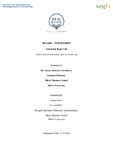Factors behind increasing slums in Dhaka city

View/Open
Date
2018-12-17Publisher
BRAC UniversityAuthor
Feroz, SanjinaMetadata
Show full item recordAbstract
Here the report starts with the organizational review from where I have completed my internship so I did my internship in a research organization and that is SRG Bangladesh Limited. Basically it [SRGB] was initiated in October 1987 as a Management and Industrial Consulting house. Its professional integrity and service excellence rapidly gained a lasting reputation for delivering result-oriented consultancy services. Then after giving brief review of SRGB I moved to my research topic. While doing my Internship at SRG Bangladesh Limited, I found out in my first project which is titled as “Public Opinion Poll: Political, Social and Economic point of view of the people in Bangladesh 2018” that almost 98% people are saying that they are either happy or they have neutral feeling with their current economic condition. The respondents were from the very remote area of Bangladesh. So here my question arrives that if the respondents are that much ok or happy with their current economic situation then why they need to migrate in Dhaka city. From that place my curiosity generated to conduct my research on this particular topic. Based on the literature review I want to identify what could be the most influencing factors behind increasing slums in Dhaka city. Though there are many factors behind this huge topic but I want to focus on the most forcing factors. So after reviewing all the journals, conference papers and newspapers as well as other secondary sources I believe there are three major factors for which slums are increasing in Dhaka city and those factors are “Poverty”, “For better employment opportunity” and “Natural calamities/disaster”. Here 100 people were surveyed as this report’s sample and among them 65 respondents did the survey from online Google form and other 35 respondents were from slums. Here, 53% respondents are male and 47% students are female. In terms of the respondents of slum, out of 35 respondent I had 23 male respondent and 12 female respondent. On the other hand, from online survey I got 30 male respondent and 35 female respondent. Besides that, 65% respondents belong to 21-25 years old age group, 17% respondents belong to 31-35 years old age group, 11% respondents belong to more than 35 years old age group, 6% belongs to 26-30 years old and only 1% belongs to 16-20 years old age group. And this total calculation is done based on both respondents from online survey as well as respondents from slum. Later on, 56% respondents assumes that “For better employment opportunity” is the prime reason for increasing slums in Dhaka city and the second reason is Natural calamities/disaster and third is poverty. Other than these factors some more factors have come out which are also big factors behind increasing slums in Dhaka city. For UPROOTED factor 23 respondent have given their consent that it can be another strong factor for which slums are increasing in Dhaka city and for MEAGER INCOME surprisingly majority of people which is 37 respondent have said that they are strongly agreeing with this factor. Even 28 respondent have also given agree option for this factor. Furthermore from some comment I found maximum people have talked about marriage, improper family planning, illiteracy, unplanned city planning, and urbanization and just want to live in Dhaka city as the reason of increasing slums in Dhaka city. Apart from these 68% respondent have said that “Employment opportunity in other countries” can be the solution for this massive issue and 30% respondent have said that “Government should take necessary steps”. Then finally after analysing the data in SPSS I increasing slums in Dhaka city is mainly affected by three hypothesizes which are For Better Job Opportunity, Natural Disaster and Poverty. Nevertheless, if I compare among these three factors then the most influencing factor is For Better Job Opportunity and then Natural disaster and the last reason would be poverty based on both beta value as well as significance value. All in all, I have also cited some experiments and challenges or limitations but I believe it will always be there in every research but there will also be present possibilities for enhancement and do better further. Presence of flaws are very natural but there should be enough strong points to overcome those flaws. Lastly there will be summary of the discussion of the report but with more of a concise and recommended mode.
